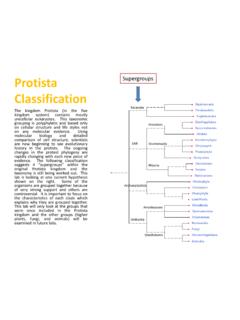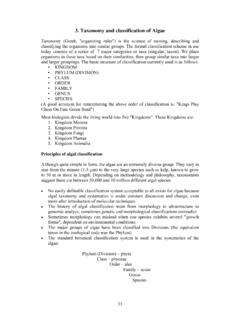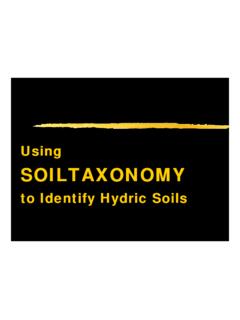Transcription of OECD GUIDELINE FOR TESTING OF CHEMICALS
1 1 ANNEX 1 April 2005 OECD GUIDELINE FOR TESTING OF CHEMICALS PROPOSAL FOR REVISED INTRODUCTION TO THE OECD guidelines FOR TESTING OF CHEMICALS , SECTION 3 PART 1: PRINCIPLES AND STRATEGIES RELATED TO THE TESTING OF DEGRADATION OF organic CHEMICALS ENV/JM/TG(2005)5/REV1 2 DEGRADATION OF organic CHEMICALS 1. GENERAL 1. Information on the degradability of organic CHEMICALS may be used for hazard assessment or for risk assessment. Hazard assessment or risk in general, and aquatic hazard classification in particular, are normally based on data obtained in standardised tests for ready biodegradability, but results of tests simulating the biodegradation in water, aquatic sediment and soil may also be used for these purposes.
2 Other types of test data that may be considered in an assessment of the potential environmental hazard or risk include sewage treatment plant (STP) simulation data, inherent biodegradability, anaerobic biodegradability, biodegradability in seawater and abiotic transformation. 2. In order to assess the environmental risk of particular CHEMICALS , information allowing the estimation of its likely concentrations in the environment is necessary. Such an estimate must initially be based on knowledge of the likely use and disposal patterns of the chemical , its physical- chemical properties and the characteristics of the receiving environment 3. Degradation of organic CHEMICALS in the environment influences exposure and, hence, it is a key parameter for estimating the risk of long-term adverse effects on biota.
3 Degradation rates, or half-lives, are preferably determined in simulation biodegradation tests conducted under conditions that are realistic for the particular environmental compartment ( STP, surface water, sediment or soil). Simulation tests aim at mimicking actual environmental conditions such as redox potential, pH, temperature, microbial community, concentration of test substance and occurrence and concentration of other substrates. 4. These are important factors that determine the environmental degradation of organic CHEMICALS in combination with the intrinsic properties of the chemical . The purpose of this introduction is to describe the principles of different types of degradation tests and to present guidance for the interpretation and use of degradability data.
4 2. BIODEGRADATION IN WATER, SOILS AND SEDIMENTS Introduction 5. Because of the large number of CHEMICALS that are being used in society an approach is required, which provides adequate knowledge for decision making as regards environmental protection, but which at the same time enables costs for TESTING to be kept to a minimum. Ideally, a system is required that allows preliminary screening of CHEMICALS , using relatively simple tests of ultimate biodegradability, with the identification of those CHEMICALS for which more detailed, and hence more costly, studies are needed. It is possible to organise the examination of the biodegradability of CHEMICALS into a general TESTING strategy, consisting of tests of varying complexity, environmental realism and cost: First, aerobic biodegradability should be examined in a screening test for ready biodegradability In the case of a negative result in a test for ready biodegradability, biodegradation of the chemical may be examined in a simulation test to obtain data to be used for assessing the biodegradation rate in the environment or in a biological STP.
5 This would also be the case when a positive result for ready biodegradability has been obtained but when a more precise biodegradation half-life or DT50 is needed for risk assessment. Alternatively or as a supplement a screening test for inherent biodegradability may be conducted for generation of data describing the potential biodegradability 3 under optimised aerobic conditions, such as those which may potentially occur in STPs at long sludge ages. In addition, potential biodegradability under anoxic conditions may be examined in a screening test for anaerobic biodegradability. Definitions Ready biodegradability tests 6. Stringent screening tests, conducted under aerobic conditions, in which a high concentration of the test substance (in the range of 2 to 100 mg/L) is used and biodegradation is measured by non-specific parameters like Dissolved organic Carbon (DOC), Biochemical Oxygen Demand (BOD) and CO2 production.
6 Domestic sewage, activated sludge or secondary effluent is the typical source of microorganisms (inoculum) in tests for ready biodegradability. The inoculum should not have been pre-adapted to degradation of the test substance by previous exposure to the test substance or structurally related CHEMICALS . A positive result in a test for ready biodegradability can be considered as indicative of rapid and ultimate degradation1 in most environments including biological STPs. 7. A chemical attaining the pass level in these tests at a certain rate after termination of the lag phase may be classified as readily biodegradable.
7 The pass level depends on the analytical parameter measured. Simulation tests 8. Aerobic and anaerobic tests that provide data for biodegradation under specified environmentally relevant conditions. These tests simulate the degradation in a specific environment by use of indigenous biomass, media, relevant solids ( soil, sediment, activated sludge or other surfaces) to allow sorption of the chemical , and a typical temperature which represents the particular environment. A low concentration of test substance is used in tests designed to determine the biodegradation rate constant whereas higher concentrations are normally used for identification and quantification of major transformation products for analytical reasons.
8 9. A low concentration of chemical in these types of tests refers to a concentration ( less than 1 g/L to 100 g/L), which is low enough to ensure that the biodegradation kinetics obtained in the test reflect those expected in the environment being simulated. Biodegradation is measured either by radiolabelling techniques or by specific chemical analyses. Tests of these types may be subdivided according to the environment that they are designed to simulate, : a) soil, b) aquatic sediments, c) surface water and d) STPs. Inherent biodegradability tests 10. Aerobic tests that possess a high capacity for degradation to take place, and in which biodegradation rate or extent is measured.
9 The test procedures allow prolonged exposure of the test substance to microorganisms and a low ratio of test substance to biomass, which offers a better chance to obtain a positive result compared to tests for ready biodegradability. Some of these tests may be conducted 1 Ultimate degradation is the degradation of the substance to CO2, biomass, H2O and other inorganic substances like NH3 ENV/JM/TG(2005)5/REV1 4 using microorganisms that have previously been exposed to the test substance, which frequently results in adaptation leading to a significant increase of the degradation rate. 11. A substance yielding a positive result in a test of this type may be classified as inherently biodegradable , which, preferably, should be qualified by one of the terms "with pre-adaptation or without pre-adaptation as appropriate.
10 Because of the favourable conditions employed in these tests, rapid biodegradation in the environment of inherently biodegradable CHEMICALS cannot generally be assumed. 12. Screening tests, conducted under anoxic conditions, in which a high concentration of the test substance (mg/L) is used and biodegradation is measured by non-specific parameters like total inorganic carbon (TIC), CO2 and CH4 production. These tests are used for the evaluation of potential anaerobic biodegradability in an anaerobic digester at a given range of concentration of microorganisms. Ready biodegradability tests 13. Ready biodegradability tests must be designed so that positive results are unequivocal.
















